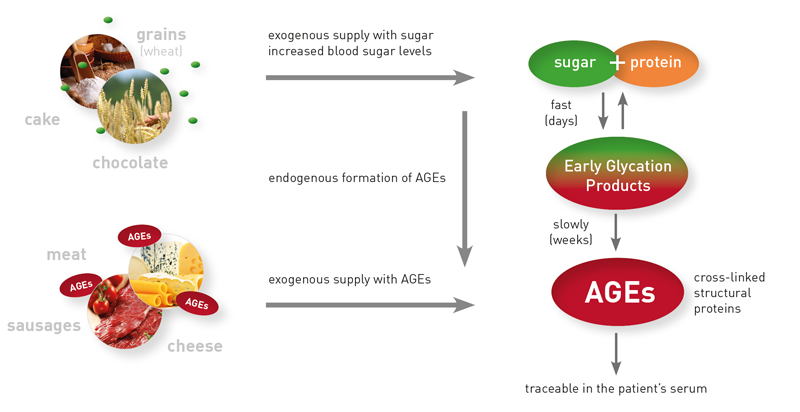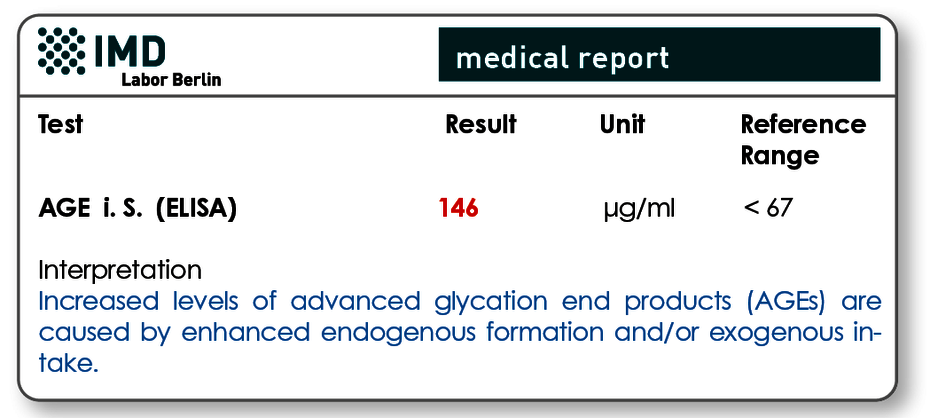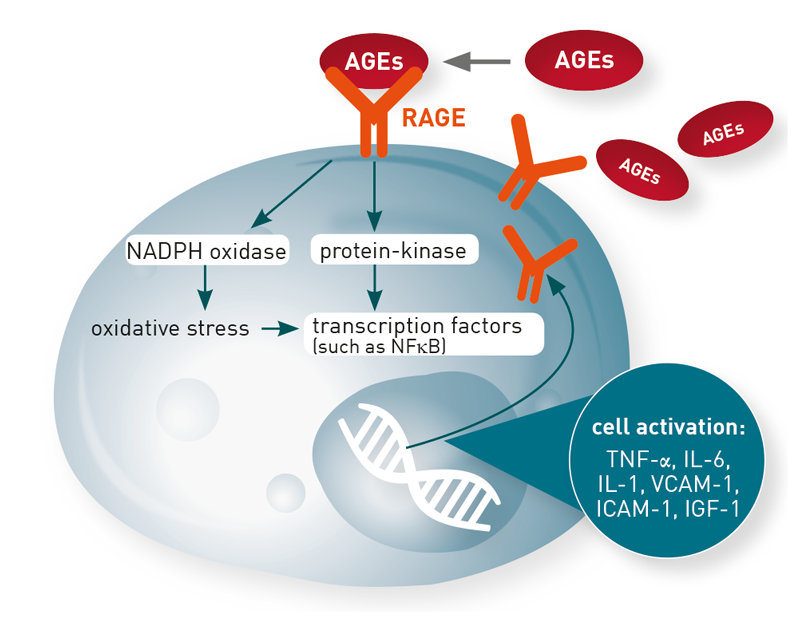Advanced Glycation End Products
Advanced glycation end products (AGEs) are risk molecules of the cellular aging process
The irreversible reaction of proteins, lipids, and nucleic acids with carbohydrates is called glycation. Glycated reaction products are termed advanced glycation end products (AGEs). It is essentially fructose, galactose, and as well glucose that react with endogenous structures in an uncontrolled manner. From a biochemical perspective, it is a multi-stage Maillard reaction with an intermediate creation of Schiff bases. Contrary to glycosylation, enzymes are not involved during the process.
When do elevated AGE levels in blood occur?
A distinction must be drawn between endogenously formed and exogenously ingested AGEs.
Especially due to an elevated supply with blood sugar, endogenous formation leads to higher AGEs concentrations in serum. Foods that elevate blood sugar levels the most are also the strongest regarding the formation of AGEs (transient hyperglycaemia). Fructose for example is more powerful regarding the formation of AGEs than glucose [1]. Grain, especially wheat, is known to be strong with respect to the formation of AGEs. Amylase “digests” wheat’s amylopectin A the fastest, which leads to a rapid increase of blood glucose levels. Independent of the supply with glycating sugar molecules, endogenous AGEs formation is significantly promoted by the presence of oxidative stress and chronic inflammation [2].
However, AGEs are not only produced endogenously within the organism, but may also be ingested via food intake. The AGEs content in food varies considerably. Meat, sausages, ham, but also cheese contain many AGEs. Especially barbecuing, pan-frying, frying and long cooking may increase AGEs levels noticeably. In general, foods that are richer in saturated fats contain higher levels of AGEs
What is the difference between AGEs and HbA1c?
HbA1c is one of the endogenously formed glycation products. In patients with diabetes, it indirectly indicates blood sugar levels of the last few weeks. However, to assess the overall glycation metabolism, AGEs are better suited. This is because modified haemoglobin does not allow for a direct deduction regarding the glycation of proteins and nucleic acids and since only with AGEs exogenously ingested glycation products are detected as well. Additionally, the AGE test does not only detect structures modified by glucose, but also the effects of fructose and galactose.

Why are AGEs harmful?
AGEs play a role in the development of different chronic inflammatory diseases, such as diabetes mellitus type II, vascular and coronary diseases [3], osteoporosis [4], and arthritis [5], in that, on the one hand, the glycation distorts the functionality of important regulatory and membrane enzymes, and on the other, AGEs themselves impact major metabolic processes. By binding to AGE receptors (RAGE) on inflammatory cells, they induce NFkB and thereby systemic inflammations and oxidative stress. In monocytes and macrophages, this stimulates the release of Interleukin-1, Interleukin-6, TNF-α and insulin-like growth factor 1 (IGF-1) [6, 7]. Endothelial cells express adhesion molecules, such as VCAM-1 and ICAM-1, which leads to an endothelial inflammation. AGEs may also activate the inducible NO synthase (iNOS) thereby increasing nitrosative stress [8]. All mentioned mediators elevate, among other things, insulin resistance, which reinforces blood sugar peaks and leads to a vicious circle. In addition, the activation of NFkB increases the cellular expression of RAGE, which adds on AGEs’ proinflammatory effect.

The glycation of neurons‘ myelin reinforces neuropathies, for example in diabetes mellitus, but also in Alzheimer’s disease [9, 10]. Food and drinks containing high concentrations of AGEs may acutely impair blood vessels’ function, while in that context long-term detrimental effects are the most alarming [11]. Various, especially short-lived substances, such as lipids, amino acids, enzymes, hormones (like insulin), or growth factors, are damaged in their structure or function due to glycation. This explains the vast number of negative impacts regarding the metabolic system.
Low AGEs levels should be the therapy’s objective
A reduction of AGEs levels in blood can be achieved with all measures lowering hyperglycaemia, reducing oxidative stress and chronic inflammation. In any case, adjusting the diet will be beneficial and therefore knowing about the individual AGE level may be motivational for the patient regarding the new diet. Next to meat, sausages, ham, cheese, and other foods with high glycaemic index, wheat and other grains are under suspicion since the ingestion of cereal products (also whole grain products) causes blood sugar levels to rise significantly (see sample report).

Material
1 ml serum
Sample receipt within 24 hrs has to be ensured. The sample should be stored and transported at room temperature. Within the Berlin city area, we offer a courier service (+49 (0)30 7701- 250). For collections beyond Berlin, please contact our complimentary courier service (+49 (0)30 77001- 450).
Invoicing
Please obtain the costs for the analysis from the pdf-document.
Would you like to see a presentation on the matter?
In our video archive, you can find a free presentation on this topic. Access is free und possible without prior registration.
Literature
[1] Sakai M, Experimental studies on the role of fructose in the development of diabetic complications. Kobe J Med Sci. 2002; 48:125-36.
[2] Schiekofer S. et al.: Acute hyperglycemia causes intracellular formation of CML and activation of ras, p42/44 MAPK, and nuclear factor kappaB in PBMCs. Diabetes 52, 2003, S. 621–633
[3] Koschinsky T, et. al. An environmental risk factor in diabetic nephropathy. PNAS 94, 1997, S. 6474–6479
[4] Sanguineti R. et al.: Advanced Glycation End Products Play Adverse Proinflammatory Activities in Osteoporosis. Mediators of inflammation 2014, 2014, S. 975872
[5] Vlassara H et al. Recent progress in advanced glycation and diabe tic vascular disease: role of advanced glycation end product receptors. Diabetes 1996; 45: 65-66
[6] Chuah et al.: Receptor for Advanced Glycation End Products and Its In volvement in Inflammatory Diseases. Int J Inflammation 2013, 2013, S. 403460
[7] Ott C. et al. Role of advanced glycation end products in cellular signaling. Redox biology 2, 2014, S. 411–429
[8] Wewer RM Arteriosclerosis and the two faces of endothelial nitric oxide synthetase Circulation 1998; 97: 108-112
[9] Singh V. P. et al.: Advanced Glycation End Products and Diabetic Complications. Korean Journal of Physiology & Pharmacology 18, 2014, S. 1–14
[10] Angeloni C. Role of Methylglyoxal in Alzheimer‘s Disease. BioMed Res Int 2014 S. 238485
[11] Uribarri J et al. Single oral challenge by advanced glycation end products acutely impairs endothelial function in diabetic and nondiabetic subjects. Diabetes Care. 2007;30:2579-82
